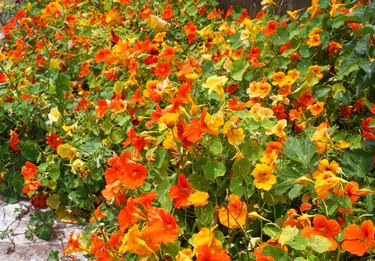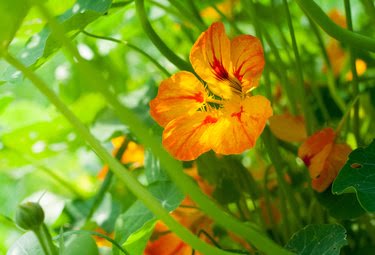Quck answer
Nasturtium is an easy-to-grow plant that adds beauty to any garden. Here are some simple steps to grow nasturtium:
1. Choose a sunny spot: Nasturtiums thrive in full sun, so pick a location that receives at least 6 hours of direct sunlight.
2. Prepare the soil: Nasturtiums prefer well-drained soil. Loosen the soil and add compost or organic matter to improve its fertility.
3. Sow the seeds: Plant the seeds directly into the soil, about 1 inch deep and 10 inches apart. Water gently to keep the soil moist.
4. Water regularly: Nasturtiums need regular watering, especially during dry periods. Avoid overwatering to prevent root rot.
5. Provide support (optional): If you want your nasturtium to climb, provide a trellis or support for the vines to grow on.
6. Enjoy the blooms: Nasturtiums produce vibrant flowers in shades of red, orange, and yellow. Pick the flowers regularly to encourage more blooms.
By following these simple steps, you can successfully grow nasturtium and enjoy its beautiful flowers throughout the growing season.
Whether peeping out from between rocks in a rock garden, cascading from hanging baskets, or adding a touch of elegance to a culinary herb garden, annual nasturtiums (Tropaeolum spp.) are reliable, traditional favorites that continue to thrive in today’s gardens. Once the blooms emerge in spring, the plants continue to produce flowers throughout the warm summer growing season.
All You Need to Know About Nasturtiums
The versatility of nasturtiums lies in the fact that there are two main types of nasturtiums. One has trailing stems (Tropaeolum majus), which can grow up to 10 feet long, while the other has a more compact, mound-like growth (Tropaeolum minus), reaching a height of less than 24 inches depending on the variety.
Nasturtium flowers are not only vibrant in earthy shades of cream, yellow, orange, and red, but they also boast a delightful spicy fragrance. Some nasturtium flowers are single, while others are double. The long petioles (leaf stalks) of the nasturtium plants are connected near the centers of the round leaves, resembling the leaves of water lilies, giving the foliage the appearance of umbrellas or parasols.
Although most nasturtiums have solid green leaves, you can find plants in the “Alaska series” if you prefer variegated foliage. These plants have green leaves that are speckled or streaked with white or cream. Tropaeolum minus ‘Alaska’ and ‘Tip Top Alaska’ are compact plants, while Tropaeolum majus ‘Jewel of Alaska’ has long climbing stems that can reach up to 8 feet.
Regardless of the species and variety, nasturtiums are fuss-free plants that even inexperienced gardeners can easily grow. You don’t need to amend the soil or fertilize these low-maintenance plants.
Top Uses for Nasturtium
In the ornamental garden, nasturtium flowers provide vibrant colors throughout a long blooming period. The best way to use them in your landscape depends on the type of nasturtium plant you have. If you have one of the shorter, compact plants, showcase them in flower beds, rock gardens, or borders. If you have one of the climbing or trailing varieties, feature them on a trellis or let them cascade from hanging baskets or window boxes.
Both types of nasturtium can also be grown as ground cover, and both are equally suitable for edible landscape designs as they are for ornamental gardens. All parts of the nasturtium plants, except for the roots, are edible. The edible flowers and leaves add color and a tangy flavor to salads, and they can also be used as a garnish for main dishes or side dishes. Even the flower buds and seedpods are edible, and they are particularly delicious when pickled and used as a substitute for capers.
As a plant that attracts pollinators, the color and shape of nasturtium flowers are particularly appealing to hummingbirds, making this plant a must-have for bird-friendly gardens. Hummingbirds are naturally attracted to colors in the red-yellow range, and they flock to nasturtiums. Apart from their colors that attract hummingbirds, nasturtium flowers also have a shape that is suited to the long tongues of these tiny birds. The funnel-shaped spurs contain nectar made of sucrose, which is more concentrated and sweeter than glucose or fructose.
Plant Profile: Nasturtium
- Common Name: Nasturtium
- Botanical Name: Tropaeolum spp.
- When to Plant: Plant seeds directly in the garden after the last spring frost
- USDA Zones: Zones 2-11 (as an annual)
- Sun Exposure: Full sun, at least six hours each day
- Soil Type: Average to poor soil of low fertility that drains well
- Signs of a Problem: Excessive heat or intense afternoon sun in warm climates may cause plants to decline and/or become leggy
- Signs of a Healthy Plant: On infertile soil, plants produce lots of flowers
How to Cultivate Nasturtium From Seed
- Begin by planting the seeds in peat pots and directly placing the pots in the garden after the last spring frost and once the seedlings appear.
- Fill the peat pots with a soilless seed-starting mix and keep the mix moist but not overly wet until it’s time to transplant the nasturtium seedlings.
- When transplanting the pots, be cautious not to damage the delicate roots.
After the last spring frost, you can directly sow the seeds:
- Sow nasturtium seeds approximately 1 inch deep and 10 inches apart in the garden.
- You can also sow groups of two or three seeds at the recommended spacing and remove all but the strongest seedling in each group by pinching.
Tip
The large seeds have a hard seed coat, so soaking them overnight may enhance germination. Although you can sow the seeds after the last spring frost, they germinate best when the soil has warmed to at least 65 degrees Fahrenheit.
In Which Zone Does Nasturtium Thrive the Most?

Image Credit:
khudoliy/iStock/GettyImages
Gardeners can cultivate nasturtiums as annuals in USDA zones 2 through 11, but they perform best in cooler summer climates. In hot climates, when temperatures rise, nasturtiums may struggle, and flower production may slow down or stop completely.
When Should You Plant Nasturtium?
Since nasturtiums are annuals, you should sow the seeds early enough to allow the plants ample time to produce numerous flowers during the growing season, but late enough in spring to avoid frost damage. Especially in Northern zones with shorter growing seasons, maximizing the blooming period requires first checking the calendar and marking the expected last frost date. When sowing seeds after this date, refer to the calendar again to determine when the first flowers can be expected, which will be six to eight weeks after sowing the seeds.
If an unexpected late frost is forecasted after the anticipated last frost date and your newly sown nasturtium seeds have already germinated, protect the delicate seedlings by covering them with a floating row cover or other lightweight fabric. Secure the ends of the row cover with U-shaped landscape pins to prevent the fabric from being blown off the seedlings. Uncover the plants the following day or when the temperature is warm enough to prevent frost damage.
Recommendations for Growing Nasturtium: Soil, Sunlight, and Water
Unlike many garden plants that require nutrient-rich soil, nasturtiums thrive in poor soil. In fact, overly fertile soil can hinder flower production and promote excessive foliage growth. Look for a sunny area in your yard with average to poor soil that is slightly acidic and well-drained to plant your nasturtiums.
Nasturtiums prefer full sun, except in regions with hot summers, such as the South. In these areas, they should be planted in a spot that provides shade or filtered sun during the harsh afternoon sun. However, if grown in a heavily shaded area, flower production will decrease.
While nasturtiums can tolerate dry soil to some extent, they still need to be watered during drought periods. If you are growing nasturtiums for their edible leaves and flowers, make sure to water them regularly during hot summers. When exposed to heat stress, the leaves and flowers develop a stronger and spicier taste compared to well-hydrated plants.
Nasturtiums do not require fertilizer, which is advantageous for gardeners who prefer low-maintenance plants. If you plant them near a lawn or as an edging plant for a flower bed, be aware that fertilizer from the surrounding grass and other plants may be washed away by rain or irrigation water, unintentionally fertilizing your nasturtiums. If you notice lush green leaves but no flowers, it is possible that the soil is naturally too fertile or that fertilizer from other plants has reached your nasturtiums.
Methods for Propagating Nasturtium
- Root the cuttings in a soilless rooting mix containing ingredients such as peat, coir, perlite, or vermiculite. Keep the cuttings moist until they develop roots.
- Grow the cuttings indoors during winter, as nasturtium is not a perennial plant that can be left outdoors to overwinter and produce new growth in spring.
- Plant the seedlings in peat pots and place them in the garden to minimize transplant issues in the following spring.
Once you have planted nasturtiums in a specific spot, they may self-sow from the seeds they produce. Therefore, if you see nasturtiums growing in the same area the next year, it is not because they are perennials. The plants from the previous year simply dropped seeds that germinated in the following spring or summer. Some types of nasturtiums, especially those with double flowers, may not produce seeds, but you can propagate them by taking cuttings before the first frost in autumn.
Harvesting Nasturtium

Image Credit:
KBelka/iStock/GettyImages
When growing nasturtiums, particularly if you plan to harvest them for consumption, avoid using pesticides on your plants. The flowers and leaves can be harvested at any time during the growing season. Young leaves are usually milder in taste, while older leaves are spicier. Store the harvested flowers and leaves in the refrigerator until ready to use in salads or other dishes.
To create “poor man’s capers,” gather the young seedpods early in the season or the closed flower buds. Use a recipe to soak the seeds or buds in brine and pickle them using vinegar.
Common Issues and Pests for Nasturtium
Nasturtiums are not often affected by insects, diseases, or pests, including deer. Occasionally, plants may be bothered by aphids, whiteflies, or mealybugs, which feed on the sap of the plants. Only in severe infestations will you notice wilting caused by their feeding. Therefore, if you spot these pests on your nasturtiums, consider the acceptable level of aesthetic damage and damage that compromises the health of your plants before resorting to chemicals.
For instance, if you only see a few insects crawling on your plants or minor stippling on the leaves from their feeding, the cosmetic damage may not be worth spraying your plants. However, if you only have a few pests, you can use a spray bottle or a water wand on your garden hose to dislodge them with a jet of water. If the number of insect pests is higher, control them using insecticidal soap as directed on the label.
If your nasturtiums become leggy in the summer heat or appear to be declining, trim them back by approximately half, and they will usually produce new growth.

